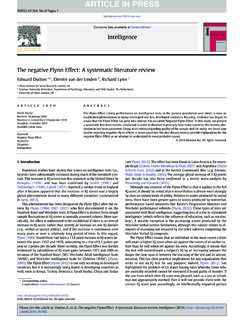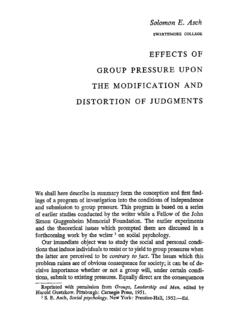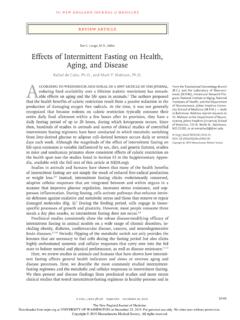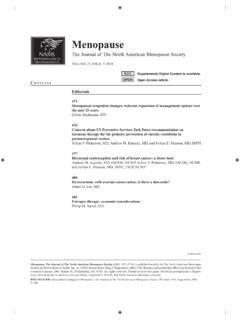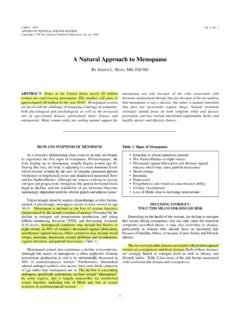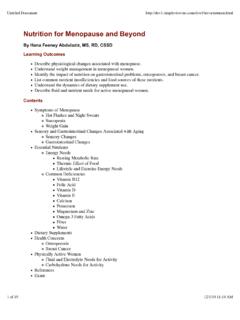Transcription of Effects of melatonin in perimenopausal and menopausal ...
1 Effects of melatonin in perimenopausal andmenopausal women: a randomized and placebocontrolled studyG. Bellipannia, P. Bianchia,1, W. Pierpaolib,*, D. Bulianb, E. IlyiacaMenopause Center, Madonna delle Grazie Health Institute, Velletri, Rome, ItalybJean Choay Institute for Biomedical Research, INTERBION Foundation and CHRONOLIFE Inc.,Via Industria 16, CH-6826 Riva San Vitale, SwitzerlandcDiagnos-Techs Inc., Kent, WA, USAR eceived 20 April 2000; received in revised form 13 October 2000; accepted 18 October 2000 AbstractIn aging humans, night levels of melatonin (MEL) decline progressively. Also thyroid and gona-dal functions decline during aging while gonadotropins (luteotropic hormone (LH) and folliclestimulating hormone (FSH)) steadily increase. A desynchronization of pineal circadian cyclicityas expressed by the progressive decrease of the MEL night peak may be permissively linked to theonset and progression of menopause . We studied the Effects of exogenous, evening administration ofMEL on the level of hormones which are known to be involved in the genesis and progression and menopausal women from 42 to 62 years of age with no pathology or medica-tion were selected.
2 MEL was measured in saliva to divide them into low, medium and high-MELpatients. Half of them took 3 mg MEL and half of them Placebo at bedtime (10 12 ) in a fullyrandomized and double-blind fashion. Three and six months later blood was taken for determinationof pituitary (LH, FSH), ovarian, and thyroid hormones I(T3and T4). All women taking MEL withlow basal level of MEL and/or Placebo for three and six months showed a signi cant increase inlevels of thyroid hormones. Before initiation of the study, a negative correlation was found in allwomen between LH, FSH and basal MEL levels. Within six months of treatment, MEL produced asigni cant diminution of LH in the younger women (43 to 49 year-old), while no effect was seen inthe older women (50 62 years old). A decrement of FSH was observed in MEL-treated women withlow basal MEL levels. In addition, most MEL-treated women reported a general improvement ofmood and a signi cant mitigation of depression.
3 MEL decline during aging may thus signal thederangement of pineal and pituitary-controlled ovarian cyclicity and the progressive quenching ofG. Bellipanni et al. / Experimental Gerontology 36 (2001) 297 310297 Experimental Gerontology 36 (2001) 297 $ - see front matterq2001 Elsevier Science Inc. All rights : S0531-5565(00)00217-5* Corresponding author. Tel.:141-91-648-2440; (W. Pierpaoli).1 Deceased on 15 October in women. These ndings seem to show a recovery of pituitary and thyroid functions inMEL-treated women, towards a more juvenile pattern of Elsevier Science rights : Pineal gland; melatonin ; Perimenopause; Thyroid function; Gonadotropins; Depression1. IntroductionA progressive reduction of nocturnal serum melatonin (MEL) concentration is observedin aging healthy humans (Iguchi et al., 1982). It is demonstrated that the pineal gland isresponsible for the development and for the maintenance of neuroendocrine and sexualfunctions.
4 In fact, the identi cation of the pineal with regard to its key role in the control ofreproductive biology, emerged from the observation of precocious puberty in childrencarrying pineal tumors (Zrenner, 1985). In non-human mammals as, the sheep,seasonal fertility and reproduction during young, reproductive age, are strictly dependenton night levels of MEL, which vary according to the seasons (temperature and photo-period). In this case MEL exerts an inhibitory action on gonadotropins and thyroidhormones (Tamarkin et al., 1985; Arendt, 1995; Vriend and Steiner, 1988). The effectof MEL seems to be related, at least to a large extent, to regulation of high-af nity MELreceptors in the neurohypophysis and on modulation of luteotropic hormone releasinghormone (LH RH) receptor density in the hippocampus and in the brain in general(anterior hypothalamus, suprachiasmatic nuclei, preoptic area ) (Reppert et al.)
5 ,1988; Morgan et al., 1992; Weaver et al., 1993). MEL administration at high, pharmaco-logical doses, inhibits gonadal function in male hamsters but this effect is especiallyevident when MEL is given at daytime rather than with nocturnal periodicity (Reiter,1980; Arendt, 1986). MEL at extremely high doses and for periods of years has also beenextensively given to thousands of young women in the attempt to develop a new kind ofcontraceptive pill, with no early or late side Effects (Cohen et al., 1996). MEL thwarts thegrowth of hormone-sensitive tumors such as certain breast cancers, and can increase thedensity of hormone receptors on cancer cells (Regelson and Pierpaoli, 1987).In the course of aging, age-related illnesses and disabilities are clearly linked to aprogressive decay of reproductive-sexual functions both in man (andropause) and inwomen ( menopause ). The progressive quenching of this basic function leads also to severeside- Effects of psychosomatic nature and to a chain of negative events which depend on theclose relationship between neuroendocrine and immune capacity and functions.
6 In fact, ithas been demonstrated that LH RH is a powerful immuno-regulating and -enhancinghormone both in ontogeny and in adult life (Marchetti et al., 1998).Findings from our laboratory have demonstrated that both administration of MEL in thenight hours and also transplantation of pineal glands from young into older mice and ratsmaintain juvenile thyroid function and signi cantly delay their aging and/or prolongs theirlife (Pierpaoli et al., 1991; Pierpaoli and Regelson, 1994). A clear-cut activity of MEL andpineal, young-to-old grafting in the maintenance of gonadal and sexual functions have alsobeen shown. A most remarkable maintenance of juvenile levels of LH RH receptors bothin the brain (hippocampus) and in the gonads is achieved by transplantation of the pinealgland from a young donor rat into older recipients (Pierpaoli et al., 1997). This effectG. Bellipanni et al. / Experimental Gerontology 36 (2001) 297 310298becomes more pronounced in the course of months after grafting, which demonstrates that,in rats, not only an arrest of sexual aging is achieved, but even a progressive reversal ofsexual functions to more juvenile levels (Pierpaoli et al.)
7 , 1997). The general conclusionderived from others' and our own work is that circadian, nocturnal administration of MELmay postpone endocrine aging and maintain or reconstitute more juvenile sexual functionsat a time of life ( between 40 and 60 years of age in women) when changes of ovariancyclicity become evident (pre-, peri- menopausal and menopausal age). The completeabsence of noxious side- Effects of MEL and the many bene cial somatic and psychologiceffects observed in humans, suggest to clinically evaluate the use of MEL in perimeno-pausal and menopausal women. Many peri- and post- menopausal women undergo ahormone replacement therapy (HRT) in the attempt to correct levels of ovarian steroids,such as estrogens and progesterone, to pre- menopause values. HRT also protects againstthe psychosomatic side- Effects of menopause and against heart disease and if MEL could not, by itself, prevent completely menopause and maintain ovariancyclicity, it may enhance and improve the ef ciency of HRT and thus add more years to awoman's fertile and healthy life.
8 It is thus worth trying MEL alone before discarding thisopportunity for prevention, delay or mitigation of menopause and its related psychoso-matic problems. An early intervention with night administration of MEL before theinitiation of ovarian dysfunction in relatively young women may indicate to us whetheror not MEL can modify the onset or the course of menopause in Patients and Patients and treatmentA formal and fully documented application for the conduction of the clinical trial wasdelivered to the Ministry of Public Health, Rome, Italy. All women joining the clinicaltrial were asked to sign an informed consent. They were given detailed information on thecharacter, duration and aims of the research. Women were carefully selected with norelevant pathologies, taking no drugs, hormones or herbal preparations and conductinga normal lifestyle with typical Mediterranean diet rich of carbohydrates and freshvegetables, with the normal sleep habits of the population of the region south of women were non-smoking or women were also given a questionnaire in which life habits, physiological data, dataconcerning previous pathologies, treatment-related side- Effects , treatment-inducedalterations, Effects on perimenopausal symptoms (neurovegetative, sleep, psychological)were recorded at time 0, and at 3 and 6 months of MEL or Placebo treatment.
9 Thequestions concerned duration and character of their menstrual cycle and/or psychosomatic,peri- and menopause -related symptoms such as irritability, morning mood and depression,insomnia, night sweatings, headache, stypsis, amnesia, hot ushes, palpitations and bodyweight recruited premenopausal (25 women), perimenopausal (36 women) and post- menopausal (18 women) women, whose age ranged from 42 to 62 were divided in two agegroups (42 49 and 50 62) in which women with similar age and peri- or post-menopausalG. Bellipanni et al. / Experimental Gerontology 36 (2001) 297 310299G. Bellipanni et al. / Experimental Gerontology 36 (2001) 297 310300 Table 1 Effect of circadian, evening administration of melatonin on thyroid function in perimenopausal and menopausal all women (42 62 years old) grouped according to theirbasal melatonin night levels (T3 and T4 were measured in blood samples taken under standardized conditions (fasting, 8 10 ) before initiation (0time) and at 3 and6 months after beginning of placebo or melatonin oral intake.)
10 Mean^SD;*p,0:05 when compared to 0 time;**p,0:0001 when compared to 0 time;ap,0:05 whencompared to placebo;bp,0:0001 when compared to placebo,NS not signi cant when compared to placebo;cp,0:05 when compared to medium levels of melatonin ;dp,0:05 when compared to high levels of melatonin . Statistical analysis was performed using ANOVA and Student'st-test. Levels of melatonin in saliva: High 300pg/ml; Medium .20 pg/ml,,300 pg/ml; Low ,20 pg/ml) melatonin levels in saliva T3 (ng/ml)T4 (ng/ml)TSH (mU/ml)036036036 monthsMelatonin(N 39) ^ ^ * ^ ** ^ ^ * ^ ** ^ ^ ^ (N 13) ^ ^ ^ * ^ ^ ^ ^ ^ ^ (N 12) ^ ^ ^ * ^ ^ ^ * ^ ^ ^ (N 13) ^ ^ * ^ * ^ ^ * ^ ** ^ ^ ^ (N 40) ^ ^ ^ * ^ ^ ^ ^ ^ ^ (N 11) ^ ^ ^ ** ^ ^ ^ ^ ^ ^ (N 14) ^ ^ ^ ^ ^ ^ ^ ^ ^ (N 13) ^ ^ ^ ^ ^ ^ ^ ^ ^ were equally distributed. In fact, in most countries and latitudes perimenopausalsymptoms and onset of menopause do not depend precisely on the age but rather on individual,environmental and genetical variability.



